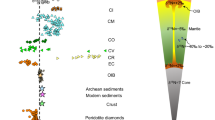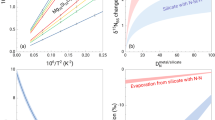Abstract
The oxygen isotope systematics in planetary and nebular matter are used to constrain the types of nebular material accreted to form a planet. The basic assumption of this model is that the mean oxygen isotopic composition of a planet is determined by the weighted mean oxygen isotopic composition of nebular matter accreted by the planet. Chondrites are taken as representatives of nebular matter. The chemical composition (which determines core size, mantle oxidation state, density, moment of inertia) of a planet results from the weighted mean compositions of the accreted nebular material, once the mass fractions of the different types of accreting matter are known. Here some results for Earth, Moon, Mars, and Vesta are discussed. The model implies that loss of volatile elements, such as alkalis and halogens, occurs during accretion and early planetary differentiation (e. g., by catastrophic impacts). The possible depletion mechanisms of moderately volatile elements are discussed.
Similar content being viewed by others
References
Anderson, D. L.: 1972, 'Internal Constitution of Mars', J. Geophys. Res. 77, 789–795.
Boesenberg, J. S., and Delaney, J. S.: 1997, 'A Model Composition of the Basaltic Achondrite Planetoid', Geochim. Cosmochim. Acta 61, 3205–3225.
Clayton, R.N.: 1993, 'Oxygen Isotopes in Meteorites', Ann. Rev. Earth Planet. Sci. 21, 115–149.
Clayton, R. N., and Mayeda, T.K.: 1983, 'Oxygen Isotopes in Eucrites, Shergottites, Nakhlites, and Chassignites', Earth Planet. Sci. Lett. 62, 1–6.
Clayton, R.N., and Mayeda, T.K.: 1984, 'The Oxygen Isotope Record in Murchison and Other Carbonaceous Chondrites', Earth Planet. Sci. Lett. 67, 151–161.
Clayton, R.N., and Mayeda, T.K.: 1996, 'Oxygen Isotope Studies of Achondrites', Geochim. Cosmochim. Acta 60, 1999–2017.
Clayton, R.N., Mayeda, T.K, Goswami, J.N, and Olsen, E. J.: 1991, 'Oxygen Isotope Studies of Ordinary Chondrites', Geochim. Cosmochim. Acta 55, 2317–2337.
Consolmagno, G. J., and Drake, M. J.: 1977, 'Composition and Evolution of the Eucrite Parent Body-Evidence From Rare Earth Elements', Geochimica et Cosmochimica Acta 41, 1271–1282.
Delaney, J. S.: 1994, 'A Model Composition for Mars Derived From the Oxygen Isotopic Ratios of Martian/SNC Meteorites', Meteoritics 29, 459 (abstract).
Dreibus, G., and Wänke, H.: 1980, 'The Bulk Composition of the Eucrite Parent Asteroid and its Bearing on Planetary Evolution', Z. Naturf. 34a, 204–216.
Dreibus, G., Brückner, J., and Wänke, H.: 1997, 'On the Core Mass of Asteroid Vesta', Meteoritics Planet. Sci. 32, A36.
Esat, T.M.: 1996, 'Comment on "Potassium Isotope Cosmochemistry: Genetic Implications of Volatile Element Depletion" by Munir Humayun and R.N. Clayton', Geochim. Cosmochim. Acta 60, 3755–3758.
Folkner, W. M., Yoder, C. F., Yuan, D.N., Standish, E.M., and Preston, R.A.: 1997, 'Interior Structure and Seasonal Mass Redistribution of Mars From Radio Tracking of Mars Pathfinder', Science 278, 1749–1752.
Humayun, M., and Clayton, R.N.: 1995, 'Potassium Isotope Cosmochemistry: Genetic Implications of Volatile Element Depletion', Geochim. Cosmochim. Acta 59, 2131–2148.
Jones, J. H.: 1984, 'The Composition of the Mantle of the Eucrite Parent Body and the Origin of Eucrites', Geochim. Cosmochim. Acta 48, 641–648.
Kitts, K., and Lodders, K.: 1998, 'Survey and Evaluation of Eucrite Bulk Compositions', Meteoritics and Planetary Sci. 33 Suppl., 197–213.
Lodders, K.: 1991, 'Spurenelementverteilung zwischen Sulfid and Silikatschmelze und kosmochemische Anwendungen,' Ph.D. Thesis, Univ. Mainz, Germany, 176 pp.
Lodders, K.: 1998, 'A Survey of SNC Meteorite Whole-Rock Compositions', Meteoritics and Planetary Sci. 33 Suppl., 183–190.
Lodders, K., and Fegley, B.: 1997, 'An Oxygen Isotope Model for the Composition of Mars', Icarus 126, 373–394.
Lodders, K., and Fegley, B.: 1998, 'The Planetary Scientist's Companion', Oxford Univ. Press.
Morgan, J.W., Higuchi, H., Takahashi, H., and Hertogen, J.: 1978, 'A "Chondritic" Eucrite Parent Body: Inference From Trace Elements', Geochim. Cosmochim. Acta 42, 27–38.
Righter, K., and Drake, M. J.: 1997, 'A Magma Ocean on Vesta: Core Formation and Petrogenesis of Eucrites and Diogenites', Meteoritics and Planetary Sci. 32, 929–944.
Ringwood, A. E.: 1979, 'Origin of the Earth and Moon', Springer Verlag, New York.
Shearer, C.K., Fowler, G.W., and Papike, J. J.: 1997, 'Petrogenic Models for Magmatism on the Eucrite Parent Body: Evidence From Orthopyroxene in Diogenites', Meteoritics Planet. Sci. 32, 877–889.
Stolper, E.: 1977, 'Experimental Petrology of Eucritic Meteorites', Geochim. Cosmochim. Acta 41, 587–611.
Takeda, H.: 1997, 'Mineralogical Records of Early Planetary Processes on Howardite, Eucrite, Diogenite Parent Body With Reference to Vesta', Meteoritics and Planet. Sci. 32, 841–853.
Thomas, P.C., Binzel, R. P., Gaffey, M. J., Zellner, B.H., Storrs, A.D., and Wells, E.: 1997, 'Vesta: Spin Pole, Size, and Shape From HST Images', Icarus 128, 88–94.
Wänke, H., and Dreibus, G.: 1988, 'Chemical Composition and Accretion History of Terrestrial Planets', Phil. Trans. R. Soc. Lond. A325, 545–557.
Young, E.D., Nagahara, H., Mysen, B.O., and Audet, D. M.: 1998, 'Non-Rayleigh Oxygen Isotope Fractionation by Mineral Evaporation: Theory and Experiments in the System SiO2', Geochim. Cosmochim. Acta 62, 3109–3116.
Zhang, Y.: 1998, 'The Young Age of Earth', Geochim. Cosmochim. Acta 62, 3185–3189.
Author information
Authors and Affiliations
Rights and permissions
About this article
Cite this article
Lodders, K. An Oxygen Isotope Mixing Model for the Accretion and Composition of Rocky Planets. Space Science Reviews 92, 341–354 (2000). https://doi.org/10.1023/A:1005220003004
Issue Date:
DOI: https://doi.org/10.1023/A:1005220003004




